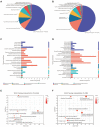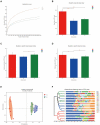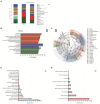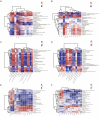Effects of Danggui Buxue decoction on host gut microbiota and metabolism in GK rats with type 2 diabetes
- PMID: 36353458
- PMCID: PMC9638067
- DOI: 10.3389/fmicb.2022.1029409
Effects of Danggui Buxue decoction on host gut microbiota and metabolism in GK rats with type 2 diabetes
Abstract
Type 2 diabetes mellitus (T2DM) is a chronic metabolic disorder characterized by persistent abnormally elevated blood sugar levels. T2DM affects millions of people and exerts a significant global public health burden. Danggui Buxue decoction (DBD), a classical Chinese herbal formula composed of Astragalus membranaceus (Huangqi) and Angelica sinensis (Danggui), has been widely used in the clinical treatment of diabetes and its complications. However, the effect of DBD on the gut microbiota of individuals with diabetes and its metabolism are still poorly understood. In this study, a T2DM model was established in Goto-Kakizaki (GK) rats, which were then treated with a clinical dose of DBD (4 g/kg) through tube feeding for 6 weeks. Next, we used 16S rRNA sequencing and untargeted metabolomics by liquid chromatography with mass spectrometry (LC-MS) to detect changes in the composition of the microbiota and cecal metabolic products. Our data show that DBD mediates the continuous increase in blood glucose in GK rats, improves insulin sensitivity, reduces expression of inflammatory mediators, and improves systemic oxidative stress. Moreover, DBD also improves microbial diversity (e.g., Romboutsia, Firmicutes, and Bacilli) in the intestines of rats with T2DM. Further, DBD intervention also regulates various metabolic pathways in the gut microbiota, including alanine, aspartate, and glutamate metabolism. In addition, arginine biosynthesis and the isoflavone biosynthesis may be a unique mechanism by which DBD exerts its effects. Taken together, we show that DBD is a promising therapeutic agent that can restore the imbalance found in the gut microbiota of T2DM rats. DBD may modify metabolites in the microbiota to realize its antidiabetic and anti-inflammatory effects.
Keywords: Danggui Buxue decoction; gut microbiota; inflammation; isoflavone; metabolism; oxidative stress; traditional Chinese medicine; type 2 diabetes mellitus.
Copyright © 2022 Wang, Fan, Ge, Li, Zhu, Yin, Xia and Xue.
Conflict of interest statement
The authors declare that the research was conducted in the absence of any commercial or financial relationships that could be construed as a potential conflict of interest.
Figures







Similar articles
-
Danggui Buxue decoction regulates the immune function and intestinal microbiota of cyclophosphamide induced immunosuppressed mice.Front Pharmacol. 2024 Aug 19;15:1420411. doi: 10.3389/fphar.2024.1420411. eCollection 2024. Front Pharmacol. 2024. PMID: 39224776 Free PMC article.
-
The antidepressant-like effects of Danggui Buxue Decoction in GK rats by activating CREB/BDNF/TrkB signaling pathway.Phytomedicine. 2021 Aug;89:153600. doi: 10.1016/j.phymed.2021.153600. Epub 2021 May 21. Phytomedicine. 2021. PMID: 34130073
-
Integration of organ metabolomics and proteomics in exploring the blood enriching mechanism of Danggui Buxue Decoction in hemorrhagic anemia rats.J Ethnopharmacol. 2020 Oct 28;261:113000. doi: 10.1016/j.jep.2020.113000. Epub 2020 Jul 12. J Ethnopharmacol. 2020. PMID: 32663590
-
Calycosin orchestrates the functions of Danggui Buxue Tang, a Chinese herbal decoction composing of Astragali Radix and Angelica Sinensis Radix: An evaluation by using calycosin-knock out herbal extract.J Ethnopharmacol. 2015 Jun 20;168:150-7. doi: 10.1016/j.jep.2015.03.033. Epub 2015 Mar 19. J Ethnopharmacol. 2015. PMID: 25796405 Review.
-
[Review of chemical constituents,pharmacological effects and clinical applications of Danggui Buxue Decoction and prediction and analysis of its Q-markers].Zhongguo Zhong Yao Za Zhi. 2021 Jun;46(11):2677-2685. doi: 10.19540/j.cnki.cjcmm.20200828.201. Zhongguo Zhong Yao Za Zhi. 2021. PMID: 34296563 Review. Chinese.
Cited by
-
Danggui Buxue decoction regulates the immune function and intestinal microbiota of cyclophosphamide induced immunosuppressed mice.Front Pharmacol. 2024 Aug 19;15:1420411. doi: 10.3389/fphar.2024.1420411. eCollection 2024. Front Pharmacol. 2024. PMID: 39224776 Free PMC article.
-
Effects of supplemental feeding of Chinese herbal mixtures to perinatal sows on reproductive performance, immunity, and breast milk quality of sows.Front Vet Sci. 2024 Dec 6;11:1445216. doi: 10.3389/fvets.2024.1445216. eCollection 2024. Front Vet Sci. 2024. PMID: 39711801 Free PMC article.
-
Hypoglycemic Effect of Edible Fungi Polysaccharides Depends on Their Metabolites from the Fermentation of Human Fecal Microbiota.Foods. 2023 Dec 27;13(1):97. doi: 10.3390/foods13010097. Foods. 2023. PMID: 38201125 Free PMC article.
-
Managing Type 2 Diabetes Mellitus via the Regulation of Gut Microbiota: A Chinese Medicine Perspective.Nutrients. 2024 Nov 18;16(22):3935. doi: 10.3390/nu16223935. Nutrients. 2024. PMID: 39599721 Free PMC article. Review.
-
The Positive Regulatory Effect of DBT on Lipid Metabolism in Postpartum Dairy Cows.Metabolites. 2025 Jan 16;15(1):58. doi: 10.3390/metabo15010058. Metabolites. 2025. PMID: 39852401 Free PMC article.
References
-
- Chen Z., Radjabzadeh D., Chen L., Kurilshikov A., Kavousi M., Ahmadizar F., et al. (2021). Association of Insulin Resistance and Type 2 diabetes with gut microbial diversity: a microbiome-wide analysis from population studies. JAMA Netw. Open 4:e2118811. doi: 10.1001/jamanetworkopen.2021.18811, PMID: - DOI - PMC - PubMed
LinkOut - more resources
Full Text Sources

